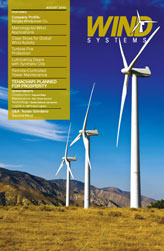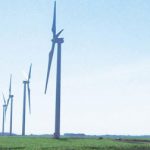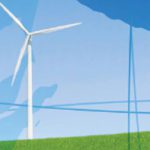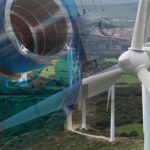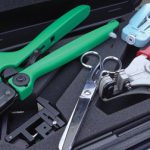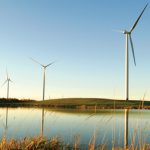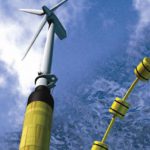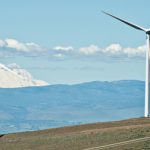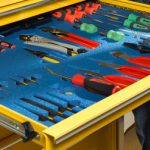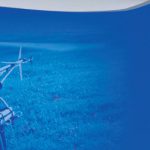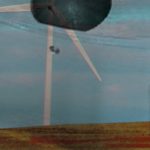A renewed focus on renewable energy has global competition heating up again for manufacturers seeking to do business with the wind power industry. There are approximately 8,000 parts in a typical wind turbine, ranging from large-scale gearboxes and blades to electronics, bolts, and fasteners. Nearly 50 percent of wind power components are made domestically, and while other parts are being produced in Europe, India and China are gearing up their capacity for manufacturing as well.
To repair a major wind power component in the field is an expensive line item. The price to repair or replace rotor blades, a gearbox, or a generator for a typical 2 MW wind turbine can be in the range of $350,000-$450,000. Given the staggering cost, wind turbine manufacturers are very reluctant to change their manufacturing process or embrace a new supplier or technology unless there is clear evidence of its impact on maintaining quality.
Hexagon Metrology—a prominent manufacturer of manual, stationary, and portable metrology solutions—has tracked measurement/inspection trends and strategies in the wind power business from the very beginning. The company leverages their broad internal expertise to help OEMs achieve critical quality control goals. As a result their acumen and knowledge base grows as metrology is applied successfully to solve problems unique to the alternative energy industry. Figure 1
Both stationary and portable coordinate measurement machines (CMMs) have a sound track record of ensuring dimensional control. For instance, wind turbine components such as blades, towers, flanges, nacelles, and cast and forged parts are inspected with portable arms and laser tracking systems. High-tech components like gears, gearboxes, and generators require higher accuracy that coordinate measuring machines provide.
And there are multiple layers of measurement and inspection processes being integrated into the design, production, alignment, and assembly of wind power systems. We will now take a look at three manufacturers who have solved formidable quality control challenges with metrology solutions and engineering know-how.
Verifying Transmission Housings for Wind Turbines
TVL (Toeleveringsbedrijf van Landuyt) in Wetteren, Belgium, finishes thousands of transmission housings for wind turbines each year. The housings are produced with high-precision machined bores with diameters of up to 64.5” (1640 mm). The tolerance for a 25.6” (650 mm) bore is ± 25 µm (±.001”), and this feature must be verified on every single unit. The bores are drilled at 0.08 percent of nominal diameter size.
“We could not measure big transmission housings in-house, so we worked with a service provider in Germany with the necessary equipment,” says Managing Director Geert Van Landuyt, adding that as production quantities grew, transportation to the service provider became a very costly proposition. “Ultimately, we needed our own coordinate measuring machine.”
Today, each four-ton transmission housing is verified on a Leitz PMM-F high precision CMM. The housings are measured in a room with the identical temperature conditions as the shop floor. This environmental control eliminates the usual waiting times required when parts must adjust to ambient temperatures in a thermally-controlled metrology lab.
The CMM’s monolithic gantry design has a length of 14.6 ft (4.5 meters), a width of 14.2 ft. (4.36 meters), and a height of 16.5 ft. (5.09 meters). The machine has a measuring volume of 118” x 78.7” x 63” (3000 x 2000 x 1600 mm). The U-formed CMM body is made of gray granite, which does not absorb as much humidity as black granite, contributing to better overall stability of the measurement results. Figure 2
TVL transmission housings are transported with a crane to the CMM. The measuring process begins once the automated alignment of the component concludes, and the part’s temperature is read by the CMM. The actual temperature of the housing is applied to the inspection program’s data points and evaluations, thus ensuring the same measured points are taken at arbitrary temperatures each time. The entire measurement process takes about 30 minutes and includes control points in nearly inaccessible areas of the housing.
Metrology-Assisted Steel Profile Cutting
Dutch company HGG specializes in steel profile cutting and manufactures bevel cutting machines that are particularly suitable for processing large components. EEW, a German manufacturer of wind turbine components, placed an order with HGG. They needed to manufacture foundation structures (also known as tripods) using high-quality steel for an offshore wind farm. The task was to produce cylindrical members cut precisely in 3D from 400 ton steel tubes that were 196.9 ft (60 m) long x 19.7 ft (6 m) high.
HGG recognized from the beginning that adopting the correct measuring technique would be the key to the success of the project. “We like challenges,” says Peter Tool, HGG R&D manager. “Our greatest strength is that we design our systems and software from the bottom up, so we retain flexibility. Short channels of communication allow us to come up with completely new processes in very little time.”
A tube weighing 400 tons deforms under its own weight when placed on the cutting machine. This deformation changes the diameter of a tube by up to 0.787 in. (20 mm) and leads to undesirable drifts. However, the changes in diameter are not constant. When the tube rotates on the cutting machine its ovality varies with the movement of the tube. In addition, a 196.9 ft. tube sags nearly three inches at the mid-span between supports. The structural frame of the cutting machine also deforms while supporting the extremely heavy load. In the face of deformations like these, even the most accurate machines are incapable of delivering a clean cut.
And mistakes can be very costly. Each tube comes with a price tag of roughly $57,000. “With expensive material like that, cutting errors cannot be allowed to happen,” Tool says. He and his team wanted to integrate a measuring system into the cutting machine. Their main premise was that the user should know the position of the tube relative to the cutting machine at all times. If the exact coordinates and deformation of the tube on the machine were always known, it would be possible to continuously compensate for the movement of the cutting head. Tool found a suitable method of control by coupling a Leica Absolute Tracker with the cutting machine. The high precision laser tracker could not only ensure the necessary accuracy, but had the required measuring range (up to 524.9ft) for the 196.9 ft. long tubes.
“From the start, we had one objective,” he says. “The machine had to be operated precisely by a single person.” HGG fully integrated the laser tracker into the cutting machine, so the operator did not have to operate the laser tracker. The instrument tracks several reflectors on the cutting head and on the tube. Every section of the tube is fitted with a reflector that tells the cutting machine operator how much the tube is bending. The laser tracker captures the 3D coordinates of one point every 100 milliseconds. Using the acquired data, the machine cuts the enormous tubes into individual sections, and to accuracies of a fraction of a millimeter. The cutting machine software also controls the tracker, which is a task made possible by the emScon programming interface developed by Leica Geosystems, a Hexagon company.
Dimensional Control of Rotor Blade Hubs
The main rotor hub is a very critical wind turbine component, as it transfers the rotors’ energy efficiently to the main bearing and constantly withstands enormous windload. The hub connects three blades to form the rotor and, depending on the model of wind power generator, is holding the motorized pitch mechanism for each blade. The rotor itself is joined to the slowly rotating shaft or main bearing with another flange, thus forming a rigid horizontal rotation-axis into the nacelles’ gearbox.
Diameter, flatness, and orientation of each hub flange are subject to very precise quality inspections. At Xinjiang Goldwind Science & Technology Company, one of the largest turbine manufacturers in China, a Leica T-Probe and a portable LTD840 laser tracker enables a single operator to quickly inspect and document the machined “as-built” part directly on the shop floor. Due to its wireless capability the probe can be utilized to measure hidden points without direct line of sight to the laser tracker. The system’s large 3D measurement volume (0 -131.234 ft.) enables the inspection of multiple interfaces and hubs with one set-up of the instrument. Figure 3
The probing device gives Goldwind all the advantages of a fixed CMM, but does not require a measurement lab and a time-consuming logistic process to move heavy parts to the CMM table. Previously, all those inspections were carried out using dial gauges, micrometers, and calipers. Mastered by experienced users, these instruments were very accurate but only provided two-dimensional information. Due to the increased size and numbers of parts to be inspected, the old manual process became a serious bottleneck for throughput and maintaining accuracy. Computer-aided design and modern quality management techniques in this competitive business set a new level of expectation, driving their need to implement a 3D metrology device for dimensional verification.
Metrology for Field Inspection and Beyond
Inspecting wind farm components at an insolated location has been difficult, or nearly impossible, with traditional measurement equipment. Introduced this year, a new line of laser tracker opens the door to remote field inspections for the wind power industry. The Leica Absolute Tracker AT401 was designed with serious portability features: small size, light weight, and long-life battery power combined with an IP54 rating and ultra-long measurement range of 525 feet (1050 feet radially). It is the first laser tracker that can be safely and easily used outdoors, even in the rain. The entire solution packs in case small enough to fit in an overhead luggage bin, giving quality control departments the mobility to follow wind power components from factory to field.
There are also new component developments underway that will significantly change the “manufacturing-to-metrology” landscape, from lightweight materials to longer life cycles for wind power parts. As the rotor size increases on larger turbines, the new designs will likely lean toward lighter, high strength, fatigue resistant materials. The step-up (geared) gearbox used on large turbines today is expected to be replaced in future turbines with direct-shaft-to-generator technology. The nacelle contains an array of complex machinery including yaw drives, blade pitch change mechanisms, drive brakes, shafts, bearings, oil pumps and coolers, controllers, and more. These are areas where simplification and innovation will become very important. Whatever the trend, quality control will play a critical role in the development and final production of wind turbine components.



















